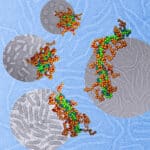
Nanoparticle-based research remains at the forefront of nanoscale approaches to targeted drug delivery and gene therapy (see related posts highlighting achievements in targeting specificity and enhanced delivery owed to high nanoparticle surface area). Recently reprinted by KurzweilAI.net, a news release from Johns Hopkins University entitled “Scientists Discover That Shape Matters in DNA Nanoparticle Therapy” describes the new findings, in which researchers from JHU and Northwestern University developed a set of DNA-copolymer nanoparticles that differ significantly in shape and in transfection efficiency.
The shapes were achieved first by mixing solutions of DNA and copolymer under varying solvent polarity conditions, allowing the micellar nanoparticles to adopt preferred configurations. The resulting shapes were similar to those observed in viral particles, with a worm-like shape predominating at higher polarities (i.e. higher water ratios). A reversible disulfide crosslinking method was then used to replicate the shapes under aqueous conditions, using cryo-TEM imaging to verify shape fidelity.
Notably, molecular dynamics simulations were conducted to model the shape transitions, providing experimentalists with time-saving predictive power.
“Our computer simulations and theoretical model have provided a mechanistic understanding, identifying what is responsible for this shape change,” Luijten said. “We now can predict precisely how to choose the nanoparticle components if one wants to obtain a certain shape. The use of computer models allowed Luijten’s team to mimic traditional lab experiments at a far faster pace.
In rat liver, the worm-like shapes, with average length of 581 nm, showed the highest gene expression, over 1,600-fold higher than that observed for spherical shapes of approximately 40 nm diameter.
While the variation in particle size may have an impact, co-corresponding author Hai-Quan Mao of JHU notes that the range of particles are similar in volume and weight, with fixed amounts of DNA. The full study, published in Advanced Materials, can be viewed in advance on line.
-Posted by Stephanie C
